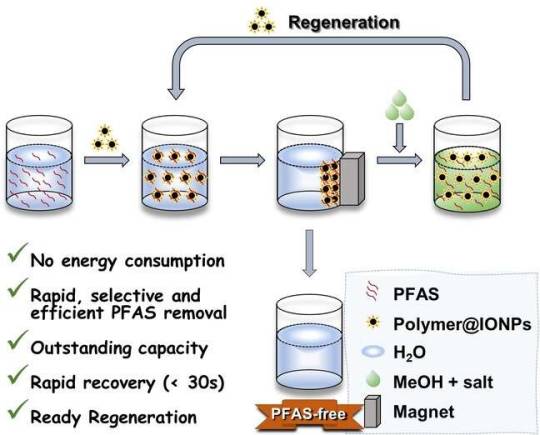#Australian Institute for Bioengineering and Nanotechnology
Text
by Australian Institute for Bioengineering and Nanotechnology (AIBN)
Researchers at The University of Queensland (UQ) are developing new 4D printing technology that produces shape-shifting liquid metals for soft robotics.
4D printing is an extension of 3D printing, where solid objects are created using materials that can change shape when exposed to certain stimuli like heat, water or light.
At UQ's Australian Institute for Bioengineering and Nanotechnology (AIBN), researchers are printing 4D structures using new liquid metal polymers that can be coaxed into performing a range of mechanical tasks with infrared lasers.
Lead researchers Dr. Liwen Zhang and Dr. Ruirui Qiao said the unique preparation methods developed by their lab allow them to produce 4D designs that are solid and durable while also being able to bend, grasp, lift, and release items five times their weight, or revert to a pre-programmed shape.
"4D printing takes traditional 3D printing and adds a new dimension—the dimension of time," Dr. Zhang said. "Our method allows us to produce smart liquid metals that can be customized, shaped and prompted to change over time without needing wires or circuits.
"This is a new era for robotics applications and a game-changer for additive manufacturing."
4D printed objects are usually prepared with a 3D printer using specific ingredients that give the finished product new qualities and abilities.
#robot#robotics#3d printing#Australian Institute for Bioengineering and Nanotechnology#soft robotics
14 notes
·
View notes
Text

#Dr Julio Aguado#Australian Institute for Bioengineering and Nanotechnology#turning back the clock on aging brains#some people look for the most minuscule detail in others#to speculate and then fabricate a story#because they revel in judgement#pay those people no attention#they are called jealous haters
1 note
·
View note
Text

Scientists use magnetic resonance microscopy as a non-invasive MRI method to visualise internal organs. This spiky-looking specimen is actually a rat kidney.
Photograph: Gary Cowin/AIBN
2023 Australian Institute For Bioengineering And Nanotechnology Image Contest
#gary cowin#photographer#australian institute for bioengineering and nanotechnology image contest#magnetic resonance microscopy#micro photography#internal organs#rat kidney#nature
13 notes
·
View notes
Photo

A magnetic method to clean PFAS contaminated water
Researchers at The University of Queensland have pioneered a simple, fast and effective technique to remove PFAS chemicals from water.
Using a magnet and a reusable absorption aid that they developed, polymer chemist Dr. Cheng Zhang and Ph.D. candidate Xiao Tan at the Australian Institute for Bioengineering and Nanotechnology have cleared 95 percent of per- and polyfluoroalkyl substances (PFAS) from contaminated water in under a minute.
"Removing PFAS chemicals from contaminated waters is urgently needed to safeguard public and environmental health," Dr. Zhang said, "But existing methods require machinery like pumps, take a lot of time and need their own power source."
"Our method shows it is possible to remove more of these chemicals in a way that is faster, cheaper, cleaner, and very simple. Because our process does not need electricity, it can be used in remote and off-grid communities."
Read more.
29 notes
·
View notes
Text
Fatty Acids Hold Clue to Creating Memories - Technology Org
New Post has been published on https://thedigitalinsider.com/fatty-acids-hold-clue-to-creating-memories-technology-org/
Fatty Acids Hold Clue to Creating Memories - Technology Org
Researchers at The University of Queensland have revealed the crucial role of saturated fatty acids in the brain’s consolidation of memories.
Dr Isaac Akefe and Professor Frederic Meunier in a QBI laboratory. Image credit: University of Queensland
Dr Isaac Akefe from UQ’s Queensland Brain Institute has uncovered the molecular mechanism and identified the genes underlying the memory creation process, opening the door to a potential treatment for neurodegenerative disorders.
“We’ve shown previously that levels of saturated fatty acids increase in the brain during neuronal communication, but we didn’t know what was causing these changes,” Dr Akefe said.
“Now for the first time, we’ve identified alterations in the brain’s fatty acid landscape when the neurons encode a memory.
“An enzyme called Phospholipase A1 (PLA1) interacts with another protein at the synapse called STXBP1 to form saturated fatty acids.”
Learning mathematics – associative photo. Image credit: Greg Rosenke via Unsplash, free license
The brain is the body’s fattiest organ, with fatty compounds called lipids making up 60% of its weight. Fatty acids are the building blocks of a class of lipids called phospholipids.
The work done in Professor Frederic Meunier’s laboratory has shown that STXBP1 controls the targeting of the PLA1 enzyme, coordinating the release of fatty acids and directing communication at the synapses in the brain.
“Human mutations in the PLA1 and the STXBP1 genes reduce free fatty acid levels and promote neurological disorders,” Professor Meunier said.
“To determine the importance of free fatty acids in memory formation, we used mouse models where the PLA1 gene is removed.
“We tracked the onset and progression of neurological and cognitive decline throughout their lives.
“We saw that even before their memories became impaired, their saturated free fatty acid levels were significantly lower than control mice.
“This indicates that this PLA1 enzyme, and the fatty acids it releases, play a key role in memory acquisition.”
The research has important implications for understanding of how memories are formed.
“Our findings indicate that manipulating this memory acquisition pathway has exciting potential as a treatment for neurodegenerative diseases, such as Alzheimer’s,” Professor Meunier said.
The research team acknowledges the contributions of PhD candidates Saber Abd Elkader from the Australian Institute for Bioengineering and Nanotechnology, and Benjamin Matthews from the Queensland Brain Institute.
The collaborative study with the University of New South Wales, University of Strasbourg, University of Bordeaux, The Scripp Research Institute and the Baylor College of Medicine.
The research paper is published in the EMBO Journal.
Source: University of Queensland
You can offer your link to a page which is relevant to the topic of this post.
#acids#Aging news#bioengineering#Biotechnology news#Brain#brains#Building#Cognitive Decline#collaborative#college#communication#consolidation#directing#Diseases#disorders#enzyme#fatty acids#Featured life sciences news#form#genes#Health & medicine news#how#human#it#Landscape#learning#Link#lipids#Mathematics#Medicine
0 notes
Link
From a heart-shaped stem cell colony to purple gold and ‘science candies’, these are the 12 finalists for the 2023 Australian Institute for Bioengineering and Nanotechnology image contest. Each year in the lead up to National Science Week, researchers...
0 notes
Text
Gene Hackers Create Meatball From Resurrected Mammoth Meat
Flesh Stunt
You've heard of attempts to resurrect extinct animals, but this one might make your stomach turn.
Vow, an Australian cultivated meat company, has cooked up in its lab one of the most exotic and downright bizarre sources of protein your taste buds could ever relish: mammoth meatballs.
And no, "mammoth" isn't a descriptor of its size. We truly mean a meatball made from the flesh of a wooly mammoth — or at least, an approximation of it. If that's turning your head, well, that's the point.
Vow wants to raise awareness of lab grown meat as a tasty and cruelty-free alternative to the real deal, not to mention one that's less environmentally destructive. In this regard, the choice of a mammoth is meant to symbolize the loss of wildlife to humans and climate change. A potent and rousing symbol, if only undermined by the fact that it comes in the form of a weighty meatball.
"We need to start rethinking how we get our food. My biggest hope for this project is... that a lot more people across the world begin to hear about cultured meat," James Ryall, Vow's chief scientific officer, told CNN.
Frankenmeat
As far as food goes, this is about as Frankenstein of a creation as it gets. First, Vow scientists grabbed the mammoth DNA sequence for myoglobin, a skeletal muscle protein found in mammals, and then filled in the gaps using elephant DNA.
To culture the meat, the scientists inserted the mammoth myoglobin sequence into the stem cells of muscle from a sheep. From there, they let the cells grow for a few weeks and voilà: mammoth meat, approximately.
And for the scientists involved, there's nothing sheepish about using lamb cells. The meatball, they say, is still mostly mammoth.
"From a genomic point of view, it's only one gene amongst all the other sheep genes that is mammoth," Ernst Wolvetang, senior group leader at the Australian Institute for Bioengineering and Nanotechnology, told CNN. "It's one gene out of 25,000."
Not For Human Consumption
If you have your reservations about eating meat from an animal that's supposed to have been dead for thousands for years, you're in good company. Vow scientists don't want to risk eating it either.
"I've got no idea what the potential allergenicity might be of this particular protein," Ryall said. "It's not going to go up for sale, because we've got no idea about the safety profile of this particular product."
But believe it or not, a veritable mammoth meat connoisseur exists, and he says he'd love to take one for the team and give the meatball a taste.
"Without doubt I would love to try this!" Love Dalén, a professor of evolutionary genomics at Stockholm University who ate a piece of frozen baby mammoth during an expedition in Sibera, told CNN.
While Vow won't be peddling mammoth meat to customers (with the possible exception of Dalen), it does want to get its other products, like cultured quail meat, into restaurants. Singapore is a hopeful target, where lab meat has already been approved for human consumption.
More on lab meat: Scientists Say They Can Make Delicious Lab-Grown Fat, Weave It Into Fake Bacon
The post Gene Hackers Create Meatball From Resurrected Mammoth Meat appeared first on Futurism.
0 notes
Text
UQ-Spin-off-Unternehmen zur Entwicklung von Präzisions-Schmerzmitteln zur Behandlung von schwächenden Erkrankungen
Präzise Schmerzmittel, die präziser und weniger schädlich für die Leber sind, sollen von einem Spin-off-Unternehmen der University of Queensland entwickelt werden -; möglicherweise das Leben von Millionen von Menschen verändern.
Professor Trent Munro, von der Das Australian Institute for Bioengineering and Nanotechnology (AIBN) ist der wissenschaftliche Mitbegründer von Cassowary Pharmaceuticals Pty Ltd das eine neue Reihe von zielgerichteten Medikamenten entwickelt.
Professo...
#Apotheke #Arthrose #Arzneimittel #Biotechnik #chronisch #Chronischer_Schmerz #Drogen #Forschung #Gürtelrose #Ischias #Krebs #Labor #Leber #Medizinische_Forschung #Molekül #Nanotechnologie #Nerv #Neuralgie #Neuropathischer_Schmerz #Schmerzen #Sucht
#Medical_Condition_News#News#Pharmaceutical_News#Apotheke#Arthrose#Arzneimittel#Biotechnik#chronisch#Chronischer_Schmerz#Drogen#Forschung#Gürtelrose#Ischias#Krebs#Labor#Leber#Medizinische_Forschung#Molekül#Nanotechnologie#Nerv#Neuralgie#Neuropathischer_Schmerz#Schmerzen#Sucht
0 notes
Text
The University of Queensland Entrepreneurial Scholar PhD Top up Scholarship in Australia for 2022/2023 - Scholarships To Study Abroad
The University of Queensland Entrepreneurial Scholar PhD Top up Scholarship in Australia for 2022/2023 – Scholarships To Study Abroad
The Entrepreneurial Scholar PhD Top Up Scholarship is an Australian Institute for Bioengineering and Nanotechnology (AIBN) for exceptional students to support their career development and industry readiness.
Successful applicants will also complete the University of Queensland’s Career Development Framework throughout their PhD, with completion of the program authorizing them for a six-month…

View On WordPress
0 notes
Text
The molecular chip is changing the face of modern manufacturing - UQ News
The molecular chip is changing the face of modern manufacturing – UQ News
Researchers at the University of Queensland have developed a new chemical process to make the molecules that are the building blocks of life-saving drugs, vaccines and energy storage materials.
Professor Matt Trau from UQ Australian Institute of Bioengineering and Nanotechnology (AIBN) received an ARC Laureate scholarship worth $2.9 million to better understand and develop the process.
“We were…
View On WordPress
0 notes
Text
How Deadly Snake Venom Could Save Your Life?
How Deadly Snake Venom Could Save Your Life?
The team comes from the Australian Institute for Bioengineering and Nanotechnology (AIBN) and has published the study in
.
Venom is normally a very complex matrix, and there are proteins in it that are essential in blood clotting. The venom gel remains in a liquid state but solidifies at a body temperature, which will give the exciting property of sealing wounds.
Advertisement
Currently, first…

View On WordPress
0 notes
Text
Brisbane’s GMG says new aluminium battery can charge 20 to 60 times faster
Brisbane’s GMG says new aluminium battery can charge 20 to 60 times faster
Good News Notes:
“Brisbane-based clean technology company Graphene Manufacturing Group says its graphene aluminium-ion batteries can charge as much as 60-times faster than the best lithium-ion batteries, and are also longer-lasting and much safer, with a lower environmental impact than traditional batteries.
GMG was founded to develop energy storage products using its own in-house proprietary…

View On WordPress
#aluminum#Australian Institute for Bioengineering and Nanotechnology#Brisbane#charging times#clean technology company#electric vehicles#energy density#GMG#good news#graphene aluminium-ion batteries#Graphene Manufacturing Group#graphite#grid storage battery systems#happy#help#joy#kindness#laptops#lithium-ion battery#lower environmental impact#need#patent-pending#phones#positive#potential benefits#power density#Uniquest#University of Queensland#watches
0 notes
Text
Is LEAPER a Safer Substitute to CRISPR?

The researchers from Peking University have developed a new gene-editing technique that they say could have profound effects on the treatment of certain diseases.
The scientists believe that it is a CRISPR alternate for fighting human diseases. They call it LEAPER. According to a research paper published on Monday in the journal Nature Biotechnology, this new tech, LEAPER, which stands for “leveraging endogenous ADAR for programmable editing of RNA,” is said to prevent several of the drawbacks of CRISPR- Cas13.

Similar to Cas13, LEAPER aims strands of RNA– molecules in cells that like DNA carry hereditary information, but also is a significant player in its replication. The technique uses engineered strands of RNA which employ another type of enzyme, ADAR, to exchange one compound found in RNA for another. This, in turn, avoids some of the problems of existing gene-editing techniques, which include immune responses and unwanted side-effects. According to the researchers, this technique is efficient, rarely misses its targets, and can be used on several different cell types.
“There are clear prospects for using this new technology in disease treatment,” said Zhou Zhuo of Peking University’s School of Life Sciences, one of the lead authors of the paper. He noted that LEAPER has the ability to precisely switch adenosine — one of the molecules that make up RNA — for one which is similar to another molecule called guanosine. That is important because almost half of the known hereditary disorders can be corrected by swapping adenosine and guanosine, Zhou told Caixin Global.
The technique has proved effective for Hurler Syndrome — a rare and devastating genetic disorder. When tested on cells taken from people with the same disease, it showed good results suggesting at its potential use in gene therapy. “[The scientists] show that in human Hurler syndrome skin cells they can correct sufficient amounts of the mutated form of RNA to restore the defective enzyme activity that causes this disease,” informed professor Ernst Wolvetang, a geneticist from the University of Queensland in Australia who was not involved in the research.
The technique seems to have “substantial potential,” and is a breakthrough toward the treatment of genetic diseases.
Dr. Wolvetang, who leads a team at the Australian Institute for Bioengineering and Nanotechnology, said the way LEAPER technology works means it might not be effective on some types of cells, and that it didn’t eliminate unwanted genetic changes. He added that the technique has not been tested on animals yet. But he said LEAPER was plainer than existing gene-editing techniques because it uses only a single component — an arRNA — while the CRISPR-Cas method uses both a Cas-enzyme and guide RNA. For this reason, it is “more easily deliverable, and less likely to result in unwanted cellular immune responses.”
Many Chinese researchers have repeatedly claimed to provide alternate to CRISPR techniques. Previously, a paper in Natural journal was published about a different pair of genetic scissors known as NgAgo, which was initially publicized as an alternative to CRISPR. However, the paper was later withdrawn after several failed attempts to replicate its findings.
Research in gene editing has invited a lot of criticism especially after a Shenzhen based scientist He Jiankui announced in November that he had used CRISPR technology to edit the genomes of 2 girls who were born the previous month.
This led the Chinese government to introduce a draft regulation in May, specifying that those who manipulate genes in embryos or human adults will be held legally responsible for the effects of their work.
New post published on: https://www.livescience.tech/2019/08/23/is-leaper-a-safer-substitute-to-crispr/
2 notes
·
View notes
Text

These cabbage-like nickel phosphate particles have been synthesised by a solvothermal process. Not suitable for Chiko Roll filler.
Photograph: Valentino Kaneti/AIBN
2023 Australian Institute For Bioengineering And Nanotechnology Image Contest
#valentino kaneti#photographer#australian institute for bioengineering and nanotechnology image contest#micro photography#cabbage-like nickel phosphate particles#solvothermal process#nature
10 notes
·
View notes
Text
Researchers Develop a universal DNA Nano-signature for early cancer detection - University of Queensland
Researchers Develop a universal DNA Nano-signature for early cancer detection – University of Queensland

Killer T cells surround cancer cell. Credit: NIH
Researchers from the University of Queensland’s Australian Institute for Bioengineering and Nanotechnology (AIBN) have discovered a unique nano-scaled DNA signature that appears to be common to all cancers.
Based on this discovery, the team has developed a novel technology that enables cancer to be quickly and easily detected from any tissue type,…
View On WordPress
#breakthrough discovery#Cancer#Genesis Nanotechnology#Nano Medicine#Nano-Bio and Bio-Medicine#Nanomaterials#Nanotechnology#University of Queensland
5 notes
·
View notes
Text
University of Queensland's Australian Institute for Bioengineering and Nanotechnology (AIBN) offers one PostDoc position
University of Queensland’s Australian Institute for Bioengineering and Nanotechnology (AIBN) offers one PostDoc position
View current academic, research and professional vacancies and apply online. UQ Jobs, University of Queensland
— Read on search.jobs.uq.edu.au/caw/en/job/514927/postdoctoral-research-fellow
View On WordPress
0 notes